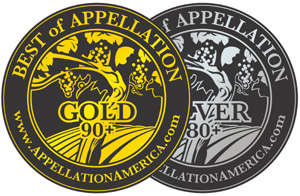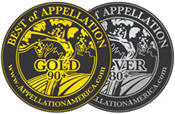

Introducing Appellation America's
Best-of-Appellation Evaluation Program
by
Roger Dial
May 8, 2008
 nlike many of our peers in this wine-ink biz, we’ve struggled long and hard over the whole issue of what constitutes “best”. The wine culture is awash with superficial scoring regimes, reductionist tasting standards, and the so-called “quality” stratification that often amounts to little more than fashion bias. Is Chardonnay somehow inherently better than Riesling, or Chenin Blanc, or Seyval Blanc? Even if one buys into the old “noble varieties” status paradigm, is Napa Valley Chardonnay somehow “better” than Long Island Chardonnay, or less good than Meursault? Are apples better than oranges?
nlike many of our peers in this wine-ink biz, we’ve struggled long and hard over the whole issue of what constitutes “best”. The wine culture is awash with superficial scoring regimes, reductionist tasting standards, and the so-called “quality” stratification that often amounts to little more than fashion bias. Is Chardonnay somehow inherently better than Riesling, or Chenin Blanc, or Seyval Blanc? Even if one buys into the old “noble varieties” status paradigm, is Napa Valley Chardonnay somehow “better” than Long Island Chardonnay, or less good than Meursault? Are apples better than oranges?
The APPELLATION AMERICA comprehensive wine database shows Chardonnay being grown in 190 North
Sadly, we humans seem driven to stratify quality in wines. A far more enriching intellectual and tasting exercise is to purposefully find the geographic and varietal differences in the wines, and then joyously revel in that diversity.
American appellations under very diverse growing conditions, with a wide range of viticultural and oenological technologies being applied. By what standard shall we judge these generally very different wines?
Sadly, we humans seem driven to stratify quality in wines. A far more enriching intellectual and tasting exercise is to purposefully find the geographic and varietal differences in the wines, and then joyously revel in that diversity.
In other words, line up our value judgments horizontally, rather than stack them up vertically.
Sounds like a good plan, eh? And, I suspect that most wine enthusiasts, including most of us “experts” who earn our living at it, sincerely believe that’s what we do. Hey, professionals or amateur enthusiasts, we’re all wine “explorers”. Sure, we each have our personal preferences, but today’s wine enthusiast typically wants to try something new, (though, alas, not necessarily something different, in terms of actual flavor profiles).
Thirty or so years ago, buying a “case” meant getting a dozen bottles of a particular brand. Cases still come with a dozen bottles, but today’s wine enthusiast usually wants 12 different wines in the box. The more adventuresome want 12 distinctly different taste experiences in the box. And for both segments, the good news is that the rapidly developing direct-to-consumer distribution system in North America makes it easier for the seekers of varied wine experiences to satisfy their curiosity and their passion for exploration.
So, now that a wine enthusiast in New York can access his wine directly from wineries in 127 different winegrowing appellations of California, and - even more long overdue! - the wine enthusiast in California can explore wines from wineries in 9 different winegrowing appellations in the state of New York, exactly what are their taste expectations about these different, often alien, products? By what yardstick are they to evaluate the diversity and/or quality of the wines now available to them?
Will the California consumer find the Long Island Chardonnay wanting because it doesn’t match the Chablis (or the Napa) Chardonnay profile he has come to know (or be told) is “best”. Will the New Yorker dismiss the Monterey Riesling as “failing” to match the Finger Lakes profile he has come to regard as “best”. And what, in God’s name, will any of them make of Viognier from the Monticello AVA (Virginia), or Norton from the Augusta AVA (Missouri), or Cabernet Sauvignon from the Sonoita AVA (Arizona), or a St. Croix from the newly designated Alexandria Lakes AVA in Minnesota?
So just what are the best wines from each appellation?
Let’s go back to where we began: Why doesn’t APPELLATION AMERICA just tell all its readers what the “best” wines are in each of the 307 diverse appellations of North America? The truth is, WE DON’T KNOW which wines are “best”, and far more importantly, we don’t have a ready-made set of regionally-informed varietal profiles which we can hold the wines up to, except in a very few appellations, mostly situated within commuting distance of the Golden Gate Bridge.Our North American wine culture will grow richer over time in direct proportion to the expansion of the number of distinct and identifiable appellation character brands that reach the public consciousness.
For sure, Napa Merlot should be judged according to the standards set by its best producers, as revealed in mountains of on-going evaluations. Ditto for Russian River Pinot Noir, and so on. But these quality profiles belong in the places where the wines were grown and the crafting decisions were made that define the special qualities of the region…place-defined “brands“, if you will. Our North American wine culture will grow richer over time in direct proportion to the expansion of the number of distinct and identifiable appellation character brands that reach the public consciousness.
But, before we can say WHICH wines are best, we need to know WHY they taste the way they do; and, more specifically, the character parameters that define what Matt Kramer has called a wine’s ‘Somewhere-ness.’ What are the signature elements of character for each region? Indeed, is ‘Somewhere-ness’ necessarily to be found expressed in every region? I think we all have a suspicion that there are a number of Nowhere appellations…not to mention quite a few Wannabe Somewhere-else appellations that are ignoring the opportunity to find and develop their own roots, so to speak.
I’ll say it again, we need to line up our value judgments horizontally, rather than stack them up vertically. To that end, APPELLATION AMERICA has designed a wine evaluation program that
 obliges the assessors to systematically evaluate the wines, individually and collectively, for place characteristics. We call it the Best-of-Appellation Evaluation Program. In the days, months, and years going forward we will be doing what our readers continually ask us to do. We’re going to look at every appellation in North America, building an on-going, ever-developing picture of the mosaic of regional character and diversity that we hope will enrich our wine culture.
obliges the assessors to systematically evaluate the wines, individually and collectively, for place characteristics. We call it the Best-of-Appellation Evaluation Program. In the days, months, and years going forward we will be doing what our readers continually ask us to do. We’re going to look at every appellation in North America, building an on-going, ever-developing picture of the mosaic of regional character and diversity that we hope will enrich our wine culture.
The trial run of the BEST-OF-APPELLATION PROGRAM was focused on wines from the several appellations strung-out along the California Sierra highlands. As indicated above, this will always be a work in progress, and by no means have we succinctly codified the regional quality parameters of the Sierra appellations. But, I think it is fair to say that several days of focused tastings, aided by lots of producer insights into what they regard as the regional definers of style and quality in their wines, has moved us a bit further d










 READER FEEDBACK: To post your comments on this story,
READER FEEDBACK: To post your comments on this story,





